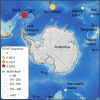A global cline in a colour polymorphism suggests a limited contribution of gene flow towards the recovery of a heavily exploited marine mammal
- PMID: 30473858
- PMCID: PMC6227926
- DOI: 10.1098/rsos.181227
A global cline in a colour polymorphism suggests a limited contribution of gene flow towards the recovery of a heavily exploited marine mammal
Abstract
Evaluating how populations are connected by migration is important for understanding species resilience because gene flow can facilitate recovery from demographic declines. We therefore investigated the extent to which migration may have contributed to the global recovery of the Antarctic fur seal (Arctocephalus gazella), a circumpolar distributed marine mammal that was brought to the brink of extinction by the sealing industry in the eighteenth and nineteenth centuries. It is widely believed that animals emigrating from South Georgia, where a relict population escaped sealing, contributed to the re-establishment of formerly occupied breeding colonies across the geographical range of the species. To investigate this, we interrogated a genetic polymorphism (S291F) in the melanocortin 1 receptor gene, which is responsible for a cream-coloured phenotype that is relatively abundant at South Georgia and which appears to have recently spread to localities as far afield as Marion Island in the sub-Antarctic Indian Ocean. By sequencing a short region of this gene in 1492 pups from eight breeding colonies, we showed that S291F frequency rapidly declines with increasing geographical distance from South Georgia, consistent with locally restricted gene flow from South Georgia mainly to the South Shetland Islands and Bouvetøya. The S291F allele was not detected farther afield, suggesting that although emigrants from South Georgia may have been locally important, they are unlikely to have played a major role in the recovery of geographically more distant populations.
Keywords: colour polymorphism; fur seal; melanocortin 1 receptor gene; pinniped; population structure.
Conflict of interest statement
The authors declare no competing financial interests.
Figures


References
-
- Raum-Suryan KL, Pitcher KW, Calkins DG, Sease JL, Loughlin TR. 2002. Dispersal, rookery fidelity, and metapopulation structure of stellar sea lions (Eumetopias jubatus) in an increasing and decreasing population in Alaska. Mar. Mammal Sci. 18, 746–764. (10.1111/j.1748-7692.2002.tb01071.x) - DOI
-
- Benestan L, Gosselin T, Perrier C, Sainte-Marie B, Rochette R, Bernatchez L. 2015. RAD genotyping reveals fine-scale genetic structuring and provides powerful population assignment in a widely distributed marine species, the American lobster (Homarus americanus). Mol. Ecol. 24, 3299–3315. (10.1111/mec.13245) - DOI - PubMed
Associated data
LinkOut - more resources
Full Text Sources
